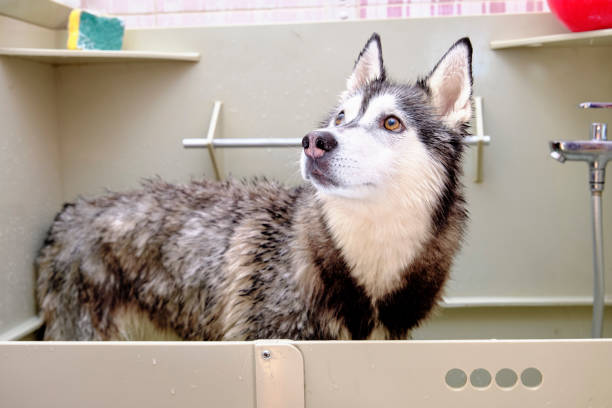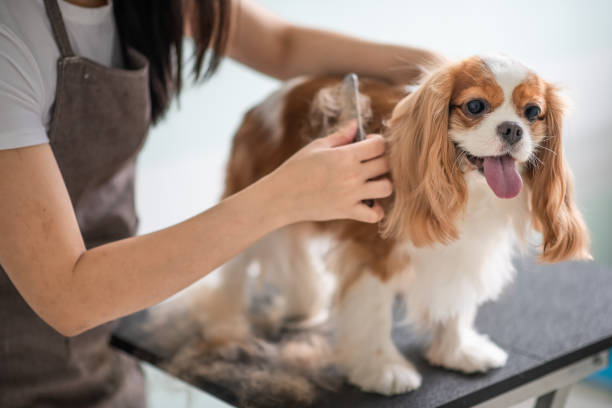As a dog groomer, your primary concern is usually the health and well-being of the pets that come through your doors. However, it's important to remember that your own health is also at risk. Groomers are exposed to a wide range of potential hazards, including chemicals, sharp tools, and infectious diseases. Among the most significant risks are respiratory hazards, which can lead to a condition known as groomer's lung. As a pet professional, you are likely aware of the many health risks associated with working with animals. One such risk is ?groomer's lung?, a serious respiratory condition that can affect anyone who regularly grooms pets. Groomer's lung is caused by inhaling particles from pet hair, skin, and dander, and it can lead to chronic respiratory problems and even lung disease over time. Fortunately, there are steps you can take to prevent groomer's lung and protect your respiratory health while working with pets. In this blog, we'll discuss the causes and symptoms of groomer's lung, as well as practical tips for preventing it. Whether you're a professional groomer, veterinarian, or animal shelter worker, this information is essential for safeguarding your health and well-being.
Why is Protective Equipment Important?
Protective equipment is designed to provide a barrier between you and potential hazards. When you wear protective equipment, you reduce your risk of exposure to harmful substances and injuries. Here are some of the key reasons why protective equipment is important for dog groomers:
Protection from airborne particles: When you groom a dog, you're exposed to a variety of airborne particles, including dander, hair, and dust. These particles can irritate your eyes, nose, and throat, and over time, they can cause serious respiratory problems.
Protection from chemicals: Many grooming products contain chemicals that can be harmful if they come into contact with your skin or if you inhale them. For example, shampoos and conditioners may contain sulfates or other harsh chemicals that can cause skin irritation or respiratory problems.
Protection from infectious diseases: Dogs can carry a variety of infectious diseases, including ringworm, parvovirus, and kennel cough. When you groom a dog, you're at risk of exposure to these diseases. Wearing protective equipment can help reduce your risk of infection.
Protection from injuries: Grooming tools like scissors and clippers can be dangerous if not used properly. Wearing gloves and eye protection can help prevent injuries from these tools.

What is Groomer's Lung?
Groomer's lung is a term used to describe a group of respiratory problems that are caused by inhaling airborne particles. These particles can include dog hair, dander, and dust from grooming products. Over time, exposure to these particles can lead to lung damage and respiratory problems.
Groomer's lung," also known as hypersensitivity pneumonitis (HP), is a condition that can result from exposure to organic dust from animal hair, feathers, or other materials. The long-term effects of groomer's lung can vary depending on the severity of the disease and the extent of lung damage.
In some cases, the lung damage caused by groomer's lung can be permanent and lead to chronic respiratory problems. This can include conditions such as chronic obstructive pulmonary disease (COPD), which can cause a persistent cough, shortness of breath, and reduced lung function.
In addition to respiratory problems, some people with groomer's lung may also develop systemic symptoms such as fatigue, fever, and weight loss. These symptoms can be more severe in cases of chronic or long-term exposure to the organic dust.
Prevention is key when it comes to avoiding groomer's lung, and individuals who work with animals or organic dust should take precautions such as wearing protective clothing and using proper ventilation. If you suspect you may have groomer's lung or are experiencing symptoms, it is important to seek medical attention promptly.
How Can you Prevent Groomer's Lung?
The best way to prevent groomer's lung is to wear protective equipment while grooming dogs. This equipment should include a mask, gloves, and eye and ear protection. To prevent groomer's lung, here are some steps that you can take:
- Wear protective equipment: Wear a KN95 protective mask or respirator style mask and goggles to prevent the inhalation of particles and dust. Use a mask that is specifically designed to filter out small particles, such as those used for painting or woodworking.
- Good ventilation: Ensure the work area is properly ventilated. Use exhaust fans or open windows to circulate the air and remove particles and dust from the air.
- Cleaning and disinfecting: Regularly clean and disinfect the work area and equipment, especially after working with animals. Use a disinfectant that is effective against bacteria and viruses and follow the instructions on the label.
- Hygiene: Practice good hygiene habits, such as washing your hands frequently with soap and water, and avoiding touching your face or mouth with your hands while working.
- Regular health check-ups: If you are a professional groomer or work with animals on a regular basis, it is recommended that you have regular check-ups with your doctor to monitor your respiratory health.
 Grooming dogs can expose you to various harmful substances such as fur, dander, and chemicals, which can cause significant damage to your eyes, ears, and lungs over time. By taking proactive measures to protect these vital organs, you can reduce the risk of developing long-term health issues such as hearing loss, respiratory problems, and eye diseases. It is essential to prioritize your health as a dog groomer to ensure you can continue to work without experiencing any adverse effects on your overall well-being. Making conscious decisions to protect your eyes, ears, and lungs may seem like a small effort, but it can have a significant impact on your long-term health. By incorporating these protective measures into your grooming routine, you can stay healthy, happy, and continue to provide quality services to your furry clients.
Grooming dogs can expose you to various harmful substances such as fur, dander, and chemicals, which can cause significant damage to your eyes, ears, and lungs over time. By taking proactive measures to protect these vital organs, you can reduce the risk of developing long-term health issues such as hearing loss, respiratory problems, and eye diseases. It is essential to prioritize your health as a dog groomer to ensure you can continue to work without experiencing any adverse effects on your overall well-being. Making conscious decisions to protect your eyes, ears, and lungs may seem like a small effort, but it can have a significant impact on your long-term health. By incorporating these protective measures into your grooming routine, you can stay healthy, happy, and continue to provide quality services to your furry clients.
